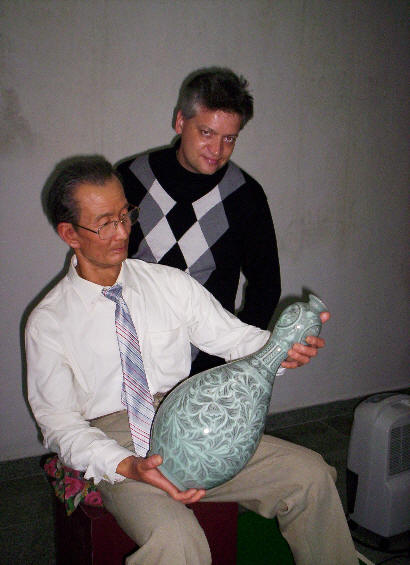Return to *North Korean Studies*
Recent Collections of Cultural Relics
Pyongyang, January 22 (KCNA) -- The Korean Folklore Museum now displays a
recent collection of cultural relics from Koryo (918-1392) and the Ri dynasty
(1392-1910). The collection gives a glimpse of Korean customs and craftsmanship.
Among them, the finest articles of academic interest are a celadon tray with
relievoed child figures, a celadon bowl, a brass mirror with a relievoed
twin-dragon design, a brass kettle, as well as women's padded jacket, padded
pajamas and footware.
The celadon tray with relievoed child figures, 18.5 cm across and 6.8 cm
tall, is elegant in shape, color and design. It gradually becomes wide slanting
from the bottom that joins the wide-flung top at a nearly vertical angle, the
whole effect reminiscent of a full-blown flower. The jade-green tray has a
relievo of three adorable children capering in the grapevines.
The celadon bowl, 14.5 cm across and 6 cm tall, is an enticing jade green,
coated with transparent glaze. It is a major source of knowledge about early-Koryo
celadon. The brass mirror with a twin dragon relievo is a round, relatively
large mirror, 23.7 cm across that is preserved in perfect original state without
any trace of damage. The front side is smooth and well polished enough to mirror
any object, while the back side has a hook for a string in the middle, the hook
surrounded by two flying dragons in bold relief.
The brass kettle, 23.5 cm tall, has a round body with a long thick neck and a
spout and handle on opposite side, thus giving an admirable symmetrical effect.
The women's padded jacket and sleeping-gown from the Ri dynasty were collected
from Singwang-ri in Haeju city, South Hwanghae Province. Made of silk, the
jacket is 66 cm long and larger-sized than others of its kind. It is believed
that these relics belong to the later 15th and early 16th centuries, in view of
the age of the tomb from which they were discovered and their styles. This
fashion of dress is visible only in the tomb murals of Koguryo (277 bc-ad 668),
but these dresses are the only real mementos ever discovered, therefore of
academic value.
A pair of shoes was also unearthed at Singwang-ri, the first ever kind of
footware from a Ri-dynasty tomb. This confirms that the dead were apparently
provided with necessary objects such as shoes in the early period of the Ri
dynasty. Through this an idea of every phase of life in those days can be
gained.
Koryo Celadon Dinner-sets
Pyongyang, December 9 (KCNA) -- The Koryo celadon dinner-sets inlaid with
cloud, pine and crane patterns from the ceramic ware unit of the Mansudae Arts
Studio, Korea's fine-arts complex, are highly valued as national treasure and on
display at the three-revolution exhibition.
Each set made up of 50 pieces, they were produced by People's Artists U Chi
Son and Im Sa Jun who invented this new elegant type of Koryo celadon with
well-blending distinctive colours and patterns and innovative forms. The ceramic
ware unit is also credited with numerous national-treasure Koryo celadon and Ri-dynasty
white porcelains. Its products bask in popularity at home and abroad.
U Chi Son - Famous Ceramic Artist
|

Master U Chi Son and Leonid Petrov |
Pyongyang, November 15 (KCNA) -- U Chi Son (80), a creator of the Mansudae
Art Studio, some days ago received a benevolent birthday
table sent by General Secretary Kim Jong Il. U Chi Son is a skillful artist who
has greatly contributed to the development of Korea's ceramic workmanship.
He is well known at home and abroad for his special contribution to
developing the Koryo ceramics with a long historical tradition to be suited to
the modern sense of beauty and emotion of the Korean people. Koryo celadon won
its fame at home and abroad already in the period of Koryo dynasty. It is
characterized with the pure and clean colour like jade, peculiar
pattern-decorated technique called Sanggam and mellow and delicate figure. But
Koryo celadon became moribund, losing its colour owing to the anti-social crimes
committed by the successive feudal rulers and the aftermath of a policy of
obliterating the national culture the Japanese pursued when they occupied Korea.
U Chi Son, who was interested in the clay art in his early days, tried to
become a ceramic craftsman by all means but his simple hope could never be
achieved during the colonial rule by the Japanese. It was only after the
liberation of the country (August, 1945) that his hope and talents could come
true. At that time, Koryo celadon was being extirpated without technique of
making it handed down. He succeeded in restoring the secret method of making
Koryo celadon with painful pursuit and efforts while working at the Koryo
ceramic institute and pottery factories. |
He has been fully displaying his talents at the craft-work production of the
Mansudae Art Studio, a comprehensive art producer of the country, since 1981. So
far he has created hundreds of famous works of national value. His works are
characterized by introduction of special techniques with the main stress laid on
the engraving decoration. His works, including flower pot and kettle, distinct,
diversified in technique, rhythmic in shape and special in pattern, enjoy the
popular favour at home and abroad. His works created a great sensation at the
several exhibitions including Koryo celadon exhibition (1983) and "modern
Koryo celadon and famous works exhibition" (1985, 1989) held in Japan. In
this period, he was awarded the titles of merited and people's artists and the
Kim Il Sung Prize. And he had honor of receiving high state commendations and
participating in the several such meetings as a national meeting of Korean
intellectuals.
His sons, too, are devoting their whole life to the creation of Koryo
ceramics succeeding to their father's business.
 Return to *North Korean Studies*
Return to *North Korean Studies*
